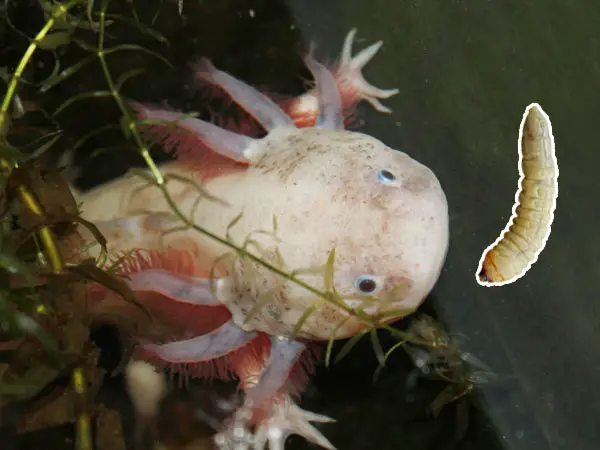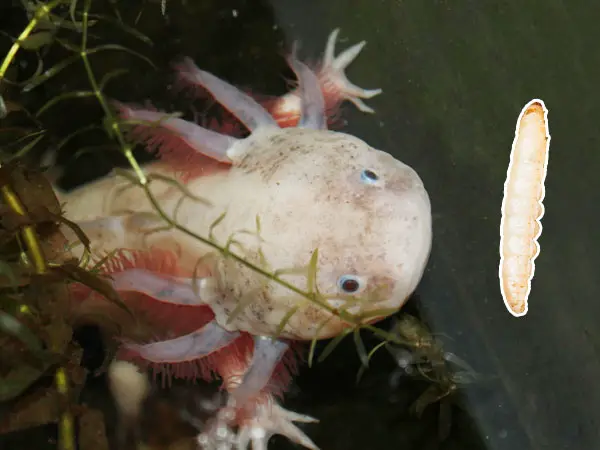Axolotls are carnivores, so biting is not only in their nature but a necessary feature for feeding purposes. While they may not pose any real risk for larger and bulkier mammals like humans, their bite is dangerous for the Axolotl’s natural prey.

But is the Axolotl likely to bite when stressed, or are they naturally inclined to violence? These are normal concerns for everyone who’s never had an Axolotl before and don’t know much about amphibians. So, let’s look closer into the issue.
Why Does Axolotl Bite Your Finger?
Axolotls have poor vision, so they use their sense of smell and hearing to detect their prey. They’re also not entirely blind, so they will distinguish movement to some degree. This can cause them to mistake your fingers for prey and act as Nature has taught them to.
They may also exhibit biting behavior if stressed or frightened by your incursion into their safe space. If that happens, leave the Axolotl alone and stick to distance watching.
An important note here, you should never immerse your hand into the Axolotl’s habitat without washing thoroughly first. Axolotls have thin and permeable skin, so they will absorb chemicals from their natural habitat via their epidermis. Any chemicals present on your hands will transmit to your Axolotl via a simple touch.
Do Axolotls Have Teeth?
Yes, Axolotls have teeth, but they’re tiny. They only use their teeth to provide some traction against their prey, but nothing else.
Does Axolotl Bite Hurt?
No, Axolotl bites don’t hurt. They will cause some mild discomfort in the area, but you shouldn’t fear any significant pain. This makes Axolotls safe even for children to handle. And by ‘handle,’ I mean take care of, because Axolotls are not to be held or petted.
These animals are extremely sensitive, with a delicate and soft body made primarily out of cartilage. So, they can easily get hurt in the process. Their skin is also thin and permeable, prone to tearing, slashing, and even chemical absorption, as I’ve already mentioned.
Ideally, you should only handle the Axolotl when absolutely necessary and only with a specifically designed net. This will minimize the contact between you and the animal, preventing any unwanted incidents.
Is Axolotl Bite Dangerous to Humans?
No, Axolotl’s bite isn’t dangerous to humans. Axolotls aren’t poisonous or venomous and their saliva poses no significant threat to humans. Primarily because the Axolotl’s bite cannot penetrate the skin.
If anything, the act of biting may actually hurt the Axolotl more than you, given the animal’s fragility and your skin’s thickness. Even if the damages aren’t necessarily physical, they are most definitely psychological. If your Axolotl is overly bitey, this could signify some form of stress that needs addressing.
Axolotls won’t attack human appendices unless mistaking them for food or feeling threatened. The latter is of utmost importance here since it speaks volumes about the animal’s state of mind.
I suggest keeping your distance if your Axolotl displays excessive aggressive tendencies. It may mean that your Axolotl is either not comfortable to your presence or that it needs space to relax and get accustomed to its surroundings.
Why do Axolotls Bite Each Other?
Keeping several Axolotls in the same habitat is both unnecessary and risky at times. These amphibians are not social creatures, so they draw no benefits from sharing their space with another of the same species. That being said, they can tolerate each other, given enough space, food, and ideal living conditions.
However, Axolotls sometimes nip, bully, or even straight-up attack each other. They are not equipped to inflict any serious injuries since Axolotls can’t actually bite but rather nip. This is due to their small mouths, unequipped for biting or chewing.
So, all they can do is poke and nip at each other to impose their will. If you own more than one Axolotl and you see them displaying aversion towards one another, consider the following:
- Improper water quality and parameters – These issues don’t necessarily instigate the Axolotls to fight each other, but it will put them into foul moods. A stressed and irritable Axolotl is more likely to snap at any other tankmate around them.
- Bully behavior – All animals showcase bully tendencies, and Axolotls are no exception. If your Axolotls differ in size significantly, the larger one is more likely to display bullying behavior at some point. If that happens, you should separate the 2 since it’s unlikely that the bullying will cease on its own.
- Underfed and growing – Axolotls have an increased appetite during their juvenile period since they experience more accelerated metabolic rates. So, the animals require more frequent feeding to remain calm and healthy. They get grumpy and may snap at their fellow tankmates if they lack proper food.
- A taste for blood – This is a weird but natural one. Some Axolotls have always displayed bully behavior, and they always will. Others will even turn cannibals, eating smaller Axolotls. At this point, they might develop a taste for Axolotl blood, and this won’t turn out well for your Axolotl community. Provided you’re courageous enough to try and set one up.
- Improper habitat setup – Overcrowding and lacking adequate hiding areas are sure to increase your Axolotls’ discomfort levels. This will cause them to become more fidgety, nip, and fight each other constantly. If that happens, either remove one or more of the Axolotls or restructure the habitat accordingly.
The main idea to consider here is that Axolotls are not social animals. So, they don’t mind living alone in their habitat; they actually prefer it that way. That being said, they will tolerate each other, all other things being optimized. Keep the water conditions impeccable, ensure enough food, and offer access to a variety of hiding areas, and your Axolotls will be more prone to tolerate one another.
Can Axolotls Chew Their Food?
No, Axolotls won’t and can’t chew their food. Instead, they create suction with their mouths to catch and swallow their prey whole. This can lead to some issues in many cases. We’re talking specifically about compaction.
Compaction occurs when the Axolotls swallows a solid piece of matter that’s not meant to be swallowed. It may be food, a piece of wood, a small rock, etc. Compaction can become severe and require surgical intervention to resolve it.
To prevent this:
- Avoid feeding your Axolotl foods containing large chunks
- Only use sand for substrate since it mimics Axolotl’s natural habitat and minimizes the risk of compaction
- Clean your Axolotl’s habitat regularly to remove any larger pieces of matter coming from plants, decorations, or food residues that the Axolotl can choke on
Conclusion
Axolotls are shy and docile animals that like solitude and privacy. Don’t handle them, eliminate and prevent all potential stress factors, and provide the animal with ideal conditions to thrive.
Axolotls can live up to 10-15 years with proper care, and they’re not that difficult to keep. The point here is – don’t handle the Axolotl and use a specialized net if you absolutely need to. This will eliminate the risks of getting bitten (not that there are any real repercussions) and prevent your Axolotl from getting stressed out.




